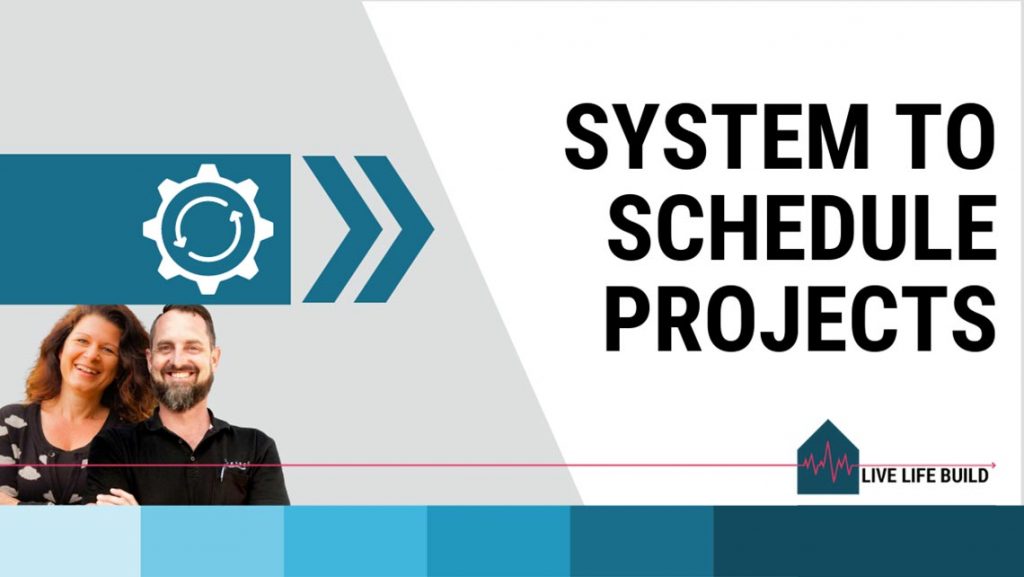Scheduling your projects makes everything in your business run more smoothly.
Learn our system for scheduling your projects here.
In this blog, we take you through the 5, 4, 3, 2, 1 of our system for scheduling your projects, so you can simplify creating your schedules, and use them to improve your business overall.
Many builders avoid doing schedules for their projects. This can mean their projects are chaotic, take huge amounts of time to coordinate and manage, and they’re constantly putting out fires on site as trades and supplies need to be ordered and organised.
When you schedule your projects, it helps with so many parts of your business. From proactively managing your projects, to setting expectations with your clients, to always having clarity about what’s needing to be done each week (well ahead of time), schedules will improve much of the way you work.
Read on, as Duayne outlines his system for scheduling your projects. He has some fantastic tips for how you can use it to plan your time, your tasks, and your team.
Check out our 5, 4, 3, 2, 1 of our 6P Methodology PROCESSES: System for Scheduling Your Projects.
5. SCHEDULING YOUR PROJECTS: MAKE SURE YOU HAVE THE RIGHT DOCUMENTS
One of the biggest ways you can improve the efficiency in your building business onsite is this: have a schedule for every single project you take on.
Now I know you’re probably wondering: why wouldn’t you have the right documents at this stage?! Because let’s face it, if you are up to this stage you’ve submitted your proposal, the client has agreed to your pricing, you’ve signed a building contract and you are basically ready to start work. Right?
Well, my experience from being in the industry for a very long time, is that I know that this isn’t normally the case.
Most builders are always rushing to get clients to sign contracts and start new projects, because they’re trying to keep their team busy, and more importantly trying to maintain cash flow in their business.
So many builders rush these last few steps and don’t have any systems or processes for checking they have all the correct documents prior to scheduling the project. Then they wonder why they have so many issues during the build.
Do you do a review to check the drawings, engineering, subcontractor pricing, all your costings and even the contract?
I believe there is no point putting time and energy into scheduling my projects if I’m still waiting for issues to be resolved with drawings. If there’s:
- still information missing from the documents (for example the plans and specifications don’t match)
- and, the most important one, information shown on the drawing doesn’t match the proposal I’ve given the clients and we have gone to contract on
… then scheduling shouldn’t be happening yet.
This is your last opportunity to make sure all the documentation you need to build a quality project is correct. Because once you schedule the job you are committed, and there is no turning back once work starts on site.
I constantly hear so many builders complaining they have to resolve issues once they start onsite. This obviously slows the job down and at the end of the day will cost you, the Builder a lot of money.
Doing checks that all the documentation is coordinated, you have all the information you need, and the drawings match with your proposal, can save you tens of thousands of dollars.
Have you got a checklist to make sure all the documents are correct prior to scheduling a project?

4. CONFIRM LEAD TIMES AND AVAILABILITY WITH ALL SUBCONTRACTORS AND SUPPLIERS
Part of having a successful project is making sure all of your materials and contractors turn up on site when they are scheduled to.
After being in the industry for 25 years and experiencing so much frustration from situations that were out of my control, I know first-hand what builders are dealing with on a daily basis. The big difference is I’ve been focussed on coming up with ways to solve the problems I was having.
The best way to make sure your jobs will run as smoothly as they can, is to make sure you’re checking in with everyone Involved prior to doing your schedule.
So what do we mean by this?
Once you’ve signed a contract and you know that the project is definitely going ahead, you should be sending out emails to all of the trades and supplies that you need for that project, to check on and confirm their lead times and availability. There’s no point scheduling materials and trades into your project schedule if they are going to be unavailable when you need them.
This is becoming more and more crucial as our industry grows, and material shortages are coming up regularly.
Doing things like this will make your business so much more efficient and allow you to be able to plan your business growth and your team more accurately.
So many builders rush to start onsite as soon as they possibly can. Most of the time this is to do with propping up their cash flow, as they need to start the project to get funds into the bank account.
Running your project like this, and not checking on the availability of materials and trades, is only adding to your pain. Because when the project gets to a stage that materials don’t show up, or one of your trades can’t show up when you expect them to, the project will come to a standstill for a day, a week, or maybe even longer.
This affects your business significantly. Having a project sitting still means:
- that you can’t get to your next progress draw
- this affects your cash flow
- the project gets off schedule
- you now have to spend time rescheduling all of the following trade and materials
- and you’ll have to be making up excuses to the client about why the project is not moving along.
How can you change this simply? Create an email template for checking trade and material availability and lead times. Then send it out prior to scheduling your projects to seek the information you need. This is a game changer.

3. DO THE OUTLINE AND THEN START WORKING BACKWARDS
So many builders we talk to don’t use schedules to run their projects.
A big part of this is because they think that scheduling is too hard.
If you are the type of builder who runs your projects
- by turning up to them a few times a week and making heaps of phone calls,
- and then yelling at people because they are turning up when you expect them to be there,
- and then wondering why you never have any spare time because you’re always putting out fires and trying to keep your jobs moving
… then you need to start scheduling your projects.
In my building business, we currently use the very simple scheduling tool, Tom’s Planner. It’s very basic, however for me, it’s all about how easy it is to use.
The best way to do your schedules is to start by doing an overall outline of the entire project.
I do this by starting at the very start of the job with an early task. Let’s say surveying. Then I work through the job putting in all of the major trades and milestones.
This then gives me an outline of the entire project, from which I can then work backwards from to put in more specific items.
For example, I mentioned in a previous point about checking your trades and suppliers lead times and availability. This is why. Once I’ve done my outline, I can then put in all my major trades on site and when we need specific items. And then I can work backwards to put in more accurate data.
So say I’ve put in the schedule the date that I’ll need to have windows on site for the carpenters to be able to install them. I know, because I’ve checked with my supplier, that their lead time will be approximately 6 weeks. This means I can now work backwards from the date that I need the windows delivered on site. And then I can also put the date in my schedule that I need to have the windows signed off and ordered by.
Another thing I like to do is then put another reminder two weeks prior to when I need the windows signed off. This reminds me that I’m getting close to needing to have that particular order signed off, and locked in, so I need to make sure it’s done.
By doing your schedules this way it means that (most of the time) trades and materials should turn up on time as you are working with their dates. Then by putting in reminders for yourself, you will have plenty of time to make sure things are locked in, and you get them when you need them.

2. SCHEDULING: SET YOURSELF UP FOR SUCCESS
As a Builder, my team and I used to waste so much time chasing up trades, materials, client decisions and orders at the last minute. We would be onsite always thinking about what was coming up next.
And so many times, we would end up in situations where a trade would be coming to site or even worse, already be onsite. And then it would be a mad rush checking and calling each other to remember where things were at or who had done what, to make sure we had the gear for them to work with.
Sound familiar?
When I’m doing my schedules and entering in all of the following tasks from my main milestone dates, I work backwards to determine:
- Lead times for my materials and trades
- When client decisions need to be made
- When we need to be booking concrete to get it onsite at 6.30am
- Engineer’s inspections
- Orders to be placed
- Even deliveries
With all of this in the schedule, my team and I can be confident that our projects will run smoothly and we can avoid all that wasted time making phone calls and doing things multiple times to get a result.
I know you are probably wondering why it’s necessary to put all those little things in, when you can just call or email people when you are getting close.
However, that will be part of the reason you are having trouble on your projects and in your business, and thinking you don’t have any time.
By putting this level of detail in your schedules, it gives you something to look at every Monday to see what tasks, follow ups and confirmations need to be done. You will be getting things done weeks in advance and not at the last minute.
This can be incredibly helpful in planning your projects, especially when you already have 50 other things to do. You’ll set yourself up for success.

1. SCHEDULE IN CLIENT SITE MEETINGS
I know lots of builders have problems with their clients attending the site when they’re not supposed to.
Want help with creating a great client relationship? Read more here.
This can be a hard one as for client building or renovating is a huge undertaking and a very exciting time in their life. I can understand the excitement from a client’s point of view, and why they want to be visiting the site to see what is happening.
We have had huge success managing our clients expectations of site visits by scheduling weekly site meetings in our project schedules. This has given our clients confidence that they will get regular interaction onsite and see what is happening.
At contract signing, we ask our clients to give us a time that will suit them on the same day, every single week, so that we can lock it into our project schedule.
Doing this has not only helped us control our clients turning up unexpectedly to our sites – it’s also saved us hours and hours every week trying to find out what time’s the clients are available, and avoided us having to go backwards and forwards trying to make a meeting that suits us and them.
Just think about how much time you spend during a project trying to liaise and coordinate site meetings with your clients.
By locking our clients into site meetings at the same time, on the same day every week, we can send out one recurring meeting invitation to lock them in for the entire length of the project (and just with one email!)
This also means that we can be far more productive during those meetings, as everybody knows that once a week we will be discussing what is in our job schedule for that period.
It also makes it super easy to lock in any meetings that the client has to have on site with other trades.
For example, when we get our clients to do a walk through with our plumber and electrician prior to them doing their rough-ins, we don’t have to be going backwards and forwards checking when our clients are available. We can make these meetings with our trades for the same time that we know we will be meeting our client on site each week.
By doing simple little things like this in your project schedules, you will not only have far smoother running projects. You will save yourself and your entire team a huge amount of time every single week that you can be putting into more important tasks to grow your business.

So, here’s our 5, 4, 3, 2, 1 to identify your ideal project.
5. Have you asked your team what their goals are?
4. How can you help and facilitate your team’s goals?
3. What are your goals as a team?
2. Holding people accountable.
1. Celebrate the wins and create a good work environment.
Live Life Build’s 6P Methodology unlocks the 6 ways to elevate your building business:
PERSONAL | PROJECTS | PEOPLE | PARTNERSHIPS | PROCESSES | PROFESSIONAL
Are you including reminders in your project schedules? Will you be including more now you’ve read this blog?

